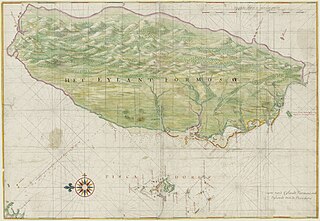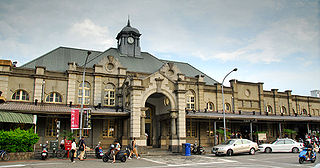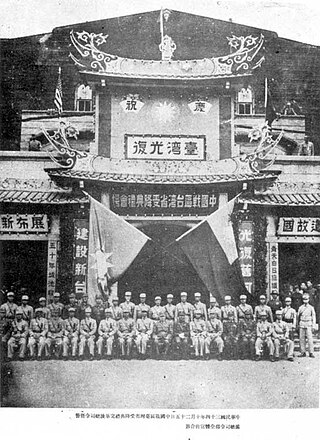
The history of the island of Taiwan dates back tens of thousands of years to the earliest known evidence of human habitation. The sudden appearance of a culture based on agriculture around 3000 BC is believed to reflect the arrival of the ancestors of today's Taiwanese indigenous peoples. People from China gradually came into contact with Taiwan by the time of the Yuan dynasty (1271–1368) and Han Chinese people started settling there by the early 17th century. The island became known by the West when Portuguese explorers discovered it in the 16th century and named it Formosa. Between 1624 and 1662, the south of the island was colonized by the Dutch headquartered in Zeelandia in present-day Anping, Tainan whilst the Spanish built an outpost in the north, which lasted until 1642 when the Spanish fortress in Keelung was seized by the Dutch. These European settlements were followed by an influx of Hoklo and Hakka immigrants from Fujian and Guangdong.

The Treaty of Shimonoseki, also known as the Treaty of Maguan in China or the Treaty of Bakan in Japan, was signed at the Shunpanrō hotel in Shimonoseki, Japan, on April 17, 1895, between the Empire of Japan and Qing China. It was an unequal treaty and ended the First Sino-Japanese War, in which Chinese land and naval forces were decisively defeated by the Japanese. The treaty was signed by Count Ito Hirobumi and Viscount Mutsu Munemitsu for Japan and Li Hongzhang and his son Li Jingfang on behalf of China.

Taiwan Province is a de jure administrative division of the Republic of China (ROC). Provinces remain a titular division as a part of the Constitution of the Republic of China, but are no longer considered to have any administrative function practically.

The Penghu or Pescadores Islands are an archipelago of 90 islands and islets in the Taiwan Strait, about 50 km (31 mi) west of the main island of Taiwan across the Penghu Channel, covering an area of 141 square kilometers (54 sq mi). The archipelago collectively forms Penghu County of Taiwan and is the smallest county of Taiwan. The largest city is Magong, on the largest island, which is also named Magong.

The Sino-French War, also known as the Tonkin War, was a limited conflict fought from August 1884 to April 1885 between the French Third Republic and Qing China for influence in Vietnam. There was no declaration of war.

The Republic of Formosa was a short-lived republic that existed on the island of Taiwan in 1895 between the formal cession of Taiwan by the Qing dynasty of China to the Empire of Japan in the Treaty of Shimonoseki and its being taken over by Japanese troops. The Republic lasted 151 days; it was proclaimed on 23 May 1895 and extinguished on 21 October, when the Republican capital Tainan was taken over by the Japanese.

Liu Yongfu was a Chinese warlord, second president of the Republic of Formosa and commander of the celebrated Black Flag Army. Liu won fame as a Chinese patriot fighting against the French Empire in northern Vietnam (Tonkin) in the 1870s and early 1880s. During the Sino-French War, he established a close friendship with the Chinese statesman and general Tang Jingsong, and in 1895, he helped Tang organise resistance to the Japanese invasion of Taiwan. He succeeded Tang as the second and last president of the short-lived Republic of Formosa.

Tang Jingsong was a Chinese general and statesman. He commanded the Yunnan Army in the Sino-French War, and made an important contribution to Qing dynasty China's military effort in Tonkin by persuading the Black Flag leader Liu Yongfu to serve under Chinese command. His intelligent, though ultimately unsuccessful, direction of the Siege of Tuyên Quang was widely praised. He later became governor of the Chinese province of Taiwan. Following China's cession of Taiwan to Japan at the end of the First Sino-Japanese War (1894–1895) he became president of the short-lived Republic of Formosa.

The Black Flag Army was a splinter remnant of a bandit and mercenary group recruited largely from soldiers of ethnic Zhuang background and former Taiping soldiers who crossed the border in 1865 from Guangxi, China into northern Vietnam, during the Nguyễn dynasty, and were hired and sponsored by Vietnamese authorities to fight against other bandits and rebels. Although brigands, they were known mainly for their fights against the invading French forces, who were then moving into Tonkin. The Black Flag Army is so named because of the preference of its commander, Liu Yongfu, for using black command flags.

Retrocession Day is the annual observance and former public holiday in Taiwan commemorating the end of Japanese rule of Taiwan and Penghu and the claimed return of Taiwan to the Republic of China on 25 October 1945. However, the idea of "Taiwan retrocession" remains in dispute.

The Japanese invasion of Taiwan, also known as Yiwei War in Chinese, was a conflict between the Empire of Japan and the armed forces of the short-lived Republic of Formosa following the Qing dynasty's cession of Taiwan to Japan in April 1895 at the end of the First Sino-Japanese War. The Japanese sought to take control of their new possession, while the Republican forces fought to resist Japanese occupation. The Japanese landed near Keelung on the northern coast of Taiwan on 29 May 1895, and in a five-month campaign swept southwards to Tainan. Although their advance was slowed by guerrilla activity, the Japanese defeated the Formosan forces whenever they attempted to make a stand. The Japanese victory at Baguashan on 27 August, the largest battle ever fought on Taiwanese soil, doomed the Formosan resistance to an early defeat. The fall of Tainan on 21 October ended organised resistance to Japanese occupation, and inaugurated five decades of Japanese rule in Taiwan.

The Battle of Baguashan, the largest battle ever fought on Taiwanese soil, was the pivotal battle of the Japanese invasion of Taiwan. The battle, fought on 27 August 1895 near the city of Changhua in central Taiwan between the invading Japanese army and the forces of the short-lived Republic of Formosa, was a decisive Japanese victory, and doomed the Republic of Formosa to early extinction. The battle was one of the few occasions on which the Formosans were able to deploy artillery against the Japanese.

The Battle of Changhsing, popularly known in Taiwan as the Battle of the Burning Village was the last set-piece battle during the Japanese invasion of Taiwan. It was fought by Hakka militia and armed civilians against the invading Imperial Japanese Army in Changhsing village (長興村). The battle earned its name from the fact that the entire village was burnt to the ground by the Japanese during their attempts to capture it from the Formosans.
The Capitulation of Tainan, on 21 October 1895, was the last act in the Japanese invasion of Taiwan. The capitulation ended the brief existence of the Republic of Formosa and inaugurated the era of Japanese colonial rule in Taiwan.

Qiu Fengjia, Chiu Feng-chia or Yau Fung-kap was a Taiwanese-born Chinese politician, educator, and poet. He was of ethnic Hakka descent.

The Pescadores campaign was the last military operation of the First Sino-Japanese War and an essential preliminary to the Japanese conquest of Taiwan.

Taiwan 1895 is a Chinese television series based on historical events that took place in Taiwan in the late Qing dynasty, such as the 1884–1885 Sino–French War and the Treaty of Shimonoseki. The series was directed by Han Gang and written by Yang Xiaoxiong. It was first broadcast in mainland China on CCTV in 2008.
Events in the year 1895 in China.

The National Flag of Republic of Formosa was used as flag and emblem of the Republic of Formosa, which was founded in Taiwan and existed from May 23 to October in 1895. Due to its design of a blue ground and a yellow tiger, it was also called the Blue Ground Yellow Tiger Flag, or simply the Yellow Tiger Flag. On the same day the flag began its usage, Tang Jingsong (唐景崧) announced the “Declaration of Independence of the Republic of Formosa.”






















